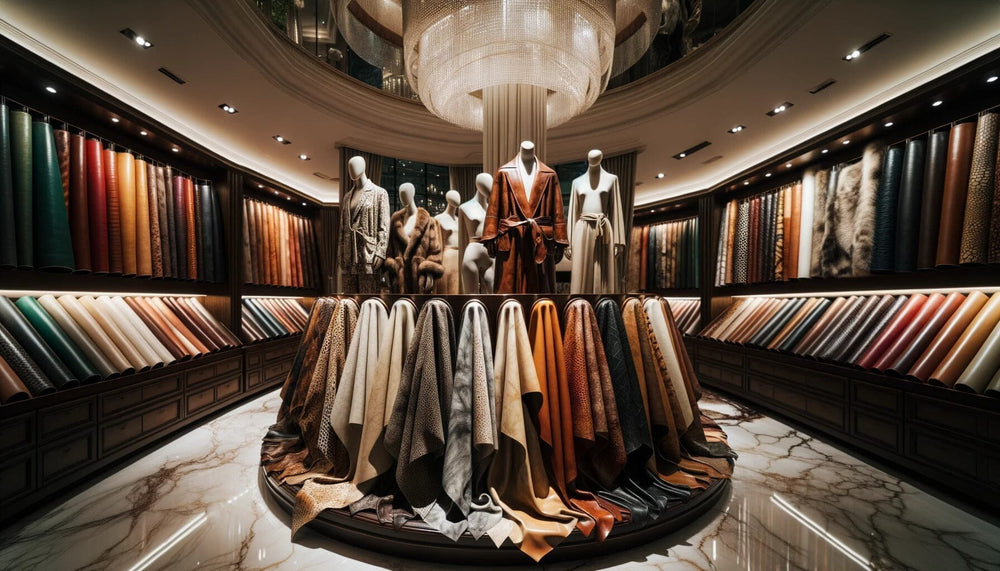
What is Exotic Leather? From Wilderness to Wardrobe
Reading Time: about
In a world where luxury is often equated with exclusivity, few materials captivate the senses like exotic leather.
From the wild landscapes of Africa to the deep waters of the Amazon, these leathers tell tales of mysterious origins and artisan craftsmanship.
But as we indulge in the opulence of these materials, there's a narrative that's equally important – one of responsibility, ethics, and sustainability.
Dive with us into the mesmerizing world of exotic leathers, and discover not just their allure, but also the stories that lie beneath their textured surfaces.
Summary
- 1. What is Exotic Leather?
- 2. What Are The Different Exotic Leather Types?
- 1. Crocodile and Alligator Leather
- 2. Ostrich Leather
- 3. Python and Snake Leather
- 4. Lizard and Iguana Leather
- 5. Stingray (Shagreen) Leather
- 6. Kangaroo Leather
- 3. Navigating the Ethical and Legal Terrain of Exotic Leather
- 4. How to Care for Exotic Leather?
- 5. FAQs
I. What is Exotic Leather?
When we talk about leather, the mind often drifts to the familiar – cowhide, perhaps goat or sheepskin. But beyond these lies a realm of luxury and rarity that many are yet to explore. I'm talking about the world of exotic leather. Let's dive deep into its essence.
1. Defining Characteristics
At the heart of every piece of exotic leather lies a story – a tale of nature's artistry and human craftsmanship. But what truly sets exotic leather apart?
Unveiling the Distinctive Traits
Firstly, the textures. While traditional leather might offer a smooth or slightly grainy feel, exotic leather is a symphony of sensations. From the pronounced quills of ostrich leather to the intricate patterns of python skin, each type offers a tactile experience that's unparalleled.
Then there's the visual appeal. Exotic leather isn't just about feel; it's a feast for the eyes. The myriad patterns, shades, and finishes available are nothing short of mesmerizing. Whether it's the iridescent sheen of stingray leather or the delicate grains of lizard skin, there's an aesthetic richness that's hard to find elsewhere.
A Symphony of Textures, Patterns, and Aesthetics
But it's not just about looks and feel. The allure of exotic leather also lies in its rarity. These aren't materials you'll find in every store or workshop. They're sourced from specific regions, often under strict regulations to ensure sustainability. This rarity adds an element of exclusivity, making every product crafted from exotic leather a statement piece.
Now, while I could wax poetic about the beauty and luxury of exotic leather all day, it's essential to remember the primary objective here: to help you, the reader, make an informed choice. Whether you're considering investing in an exotic leather product or simply curious about the world of luxury materials, understanding the defining characteristics of exotic leather can ease your research task.
And if you're wondering whether exotic leather is worth the investment, consider this: in a world where uniqueness is celebrated, wouldn't you want to own something that stands out, both in terms of aesthetics and story?

II. What Are The Different Exotic Leather Types?
1. Crocodile and Alligator Leather
The world of luxury leathers is vast, but few stand out as prominently as crocodile and alligator skins. These two, often mistaken for one another, are the epitome of opulence and sophistication. Let's delve deeper into understanding their unique characteristics, advantages, applications, and expert care tips.
Definition
Crocodile and alligator leathers are often mistaken for one another due to their visual similarities. However, upon closer inspection, one can discern subtle differences. Crocodile leather, sourced from species like the Saltwater or Nile crocodile, typically has a more symmetrical scale pattern. In contrast, alligator skin, primarily derived from the American alligator, is distinguished by an umbilical scar, a unique feature not present in crocodile hides. These nuances not only aid in authentication but also contribute to their individual allure in the world of luxury.
Pros and Cons
Navigating the world of luxury leathers, we often weigh the advantages and drawbacks of our choices. Let's delve into the pros and cons of these exquisite skins:
Pros:
- Durability: Both crocodile and alligator leathers are renowned for their toughness. Their hides are naturally resistant to tearing, stretching, and water damage, making them ideal for long-term use.
- Aesthetics: Their unique scale patterns, especially the belly sections, are highly sought after in luxury markets. The natural sheen and texture variations make each piece one-of-a-kind.
- Prestige: Owning a genuine crocodile or alligator leather item is often seen as a status symbol, reflecting a sense of luxury and sophistication.
Cons:
- Ethical Considerations: The demand for these leathers has led to concerns about overhunting and habitat destruction. It's crucial to ensure that the leather is sourced sustainably and ethically.
- Price: Their rarity, combined with the intricate processing required, often results in a premium price tag.
- Maintenance: Requires regular conditioning to prevent drying out and to maintain its luster.
Applications
Whenever we think of crocodile or alligator leather, images of opulent handbags, bespoke shoes, and elegant watch straps come to mind. These are not just accessories; they're statements. A crocodile leather handbag, for instance, can elevate an ensemble, making it red-carpet worthy. Similarly, alligator shoes are not just footwear; they're a testament to one's appreciation for craftsmanship and luxury.
Expert Tips
Having spent years understanding and appreciating these leathers, I'd like to share some nuggets of wisdom:
- Authentication: Look for the umbilical scar in alligator skins. Remember, each leather has its unique scale pattern, which can be a telltale sign of its authenticity.
- Purchase: Always buy from reputable sources. Check for certifications that ensure the leather is ethically sourced.
- Care: These leathers are durable, but they love a little pampering. Use specialized leather conditioners to keep them supple. Avoid direct sunlight, which can fade their rich colors.
While the allure of crocodile and alligator leathers is undeniable, it's essential to make informed choices. After all, luxury is not just about possession; it's also about appreciation and responsibility.
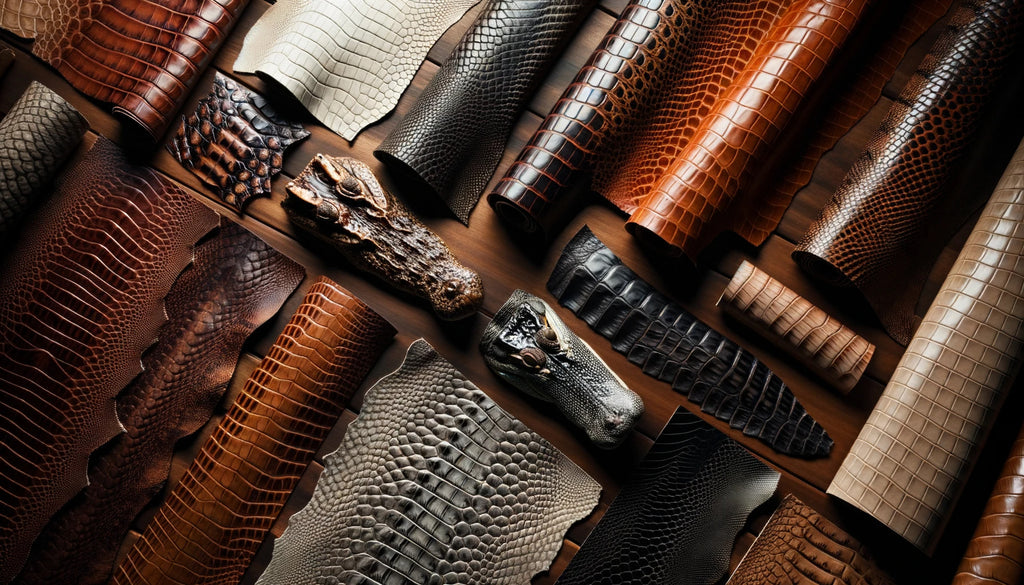
2. Ostrich Leather
Ostrich leather, with its distinctive quill follicles, has carved a niche for itself in the luxury market. Originating from the large flightless bird native to Africa, this leather offers a unique blend of softness and durability. Join me as we explore its charm, benefits, versatile applications, and maintenance insights.
Definition
Ostrich leather is instantly recognizable by its distinct pattern of quill follicles. These are the tiny bumps where the bird's feathers once were. This leather is sourced from the skin of the ostrich, primarily from its body. The charm of ostrich leather lies in these quill patterns, which give it a unique texture and aesthetic appeal, setting it apart from other leathers.
Pros and Cons
Now, let's weigh the advantages and potential drawbacks of this fascinating material:
Pros:
- Softness: One touch, and you'll immediately notice its suppleness. It's this buttery texture that makes ostrich leather a favorite for luxury items.
- Durability: Don't let its softness fool you. Ostrich leather is known for its strength and resilience, ensuring that products made from it stand the test of time.
- Sustainability: Many reputable suppliers ensure that ostrich leather is sourced responsibly, making it a more sustainable choice in the world of exotic leathers.
Cons:
- Price: The unique look and feel, combined with the limited quantity of leather each ostrich yields, can drive up costs.
- Sensitivity: Can be sensitive to oils and may darken if exposed to too much moisture.
- Ethical Concerns: Farming practices vary, and it's essential to ensure that the leather is sourced from farms that prioritize animal welfare.
Applications
So, where might you encounter this luxurious material? Ostrich leather's versatility is truly impressive. In the world of fashion, it graces the runways as statement handbags, wallets, and even footwear. But its application doesn't stop there. The automotive industry, always on the lookout for premium materials, often uses ostrich leather to elevate car interiors to new heights of luxury. And if you've ever stepped into a high-end hotel or home and noticed an exceptionally plush sofa or chair, there's a good chance ostrich leather was involved.
Expert Tips
Before we wrap up our exploration of ostrich leather, I'd like to share some pearls of wisdom I've gathered over the years:
- Maintenance is Key: To maintain its luster, regularly clean your ostrich leather items with a soft cloth and a specialized leather conditioner.
- Avoid Direct Sunlight: Just as our skin doesn't appreciate prolonged sun exposure, ostrich leather can fade or dry out if left in direct sunlight.
- Storage Matters: When not in use, store ostrich leather products in a cool, dry place. For items like bags or shoes, consider using a dust bag or box.
- Embrace its Uniqueness: No two ostrich leather items are the same. The quill patterns will vary, making each piece truly one-of-a-kind.
Ostrich leather, with its unique quill patterns and luxurious feel, offers a blend of beauty and durability that few other materials can match. Whether you're considering investing in an ostrich leather product or simply curious about its properties, I hope this guide has shed some light on this fascinating material. And remember, with the right care, ostrich leather can be a timeless treasure that brings joy for years to come.
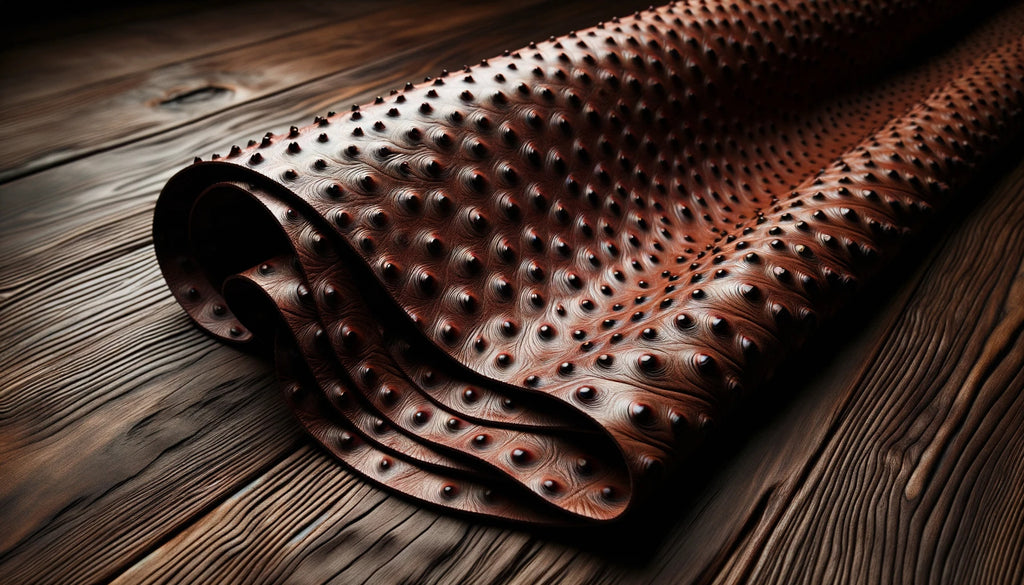
3. Python and Snake Leather
Slithering its way into the luxury segment is the enchanting python and snake leather. With a myriad of patterns and a texture that's unparalleled, snake skins have become a favorite for those seeking a bold fashion statement. Let's journey through the allure of these skins, their pros and cons, applications, and expert recommendations.
Definition
Snake leather, with python being one of the most popular, is celebrated for its intricate patterns and scales. Each snake species offers a unique pattern, making every piece of leather distinct. Python skins, in particular, are known for their large scales and the natural, varied pattern that runs the length of the hide. This variety and allure make snake skins a favorite in the fashion industry.
Pros and Cons
As with any luxury item, it's essential to weigh the benefits against the potential drawbacks. Let's break it down:
Pros:
- Beauty: The intricate patterns and scales of snake leather make it visually striking.
- Flexibility: Snake leather is highly flexible, making it suitable for a range of applications.
- Lightweight: Despite its strength, snake leather is relatively lightweight.
Cons:
- Delicacy: The scales can lift or peel over time, especially if not cared for properly.
- Sourcing Challenges: Overhunting and habitat loss are significant concerns. Ethical sourcing is paramount.
- Maintenance: Requires gentle cleaning methods and specific care products to maintain its appearance.
Applications
Over the years, I've observed that python and snake leathers have gracefully slithered their way into various fashion niches. From the runways of Milan to the bustling streets of New York, these leathers have made a statement. Here's where you'll commonly find them:
- Footwear: Python boots or snake leather shoes are not just footwear; they're a statement. The unique patterns ensure that they remain the focal point of any ensemble.
- Belts: A snake leather belt can elevate even the simplest of outfits, adding a touch of luxury.
- Accessories: From wallets to handbags, the versatility of python and snake leather shines through, making them a favorite among designers and consumers alike.
Expert Tips
Having been immersed in the world of exotic leathers for years, I've picked up a few tips and tricks along the way. Here's my advice for anyone venturing into the realm of python and snake leather:
- Care: Use a soft, damp cloth to clean the leather gently. Avoid using harsh chemicals that can damage the scales.
- Storage: Store your snake leather products in a cool, dry place. Excessive moisture can harm the leather's texture.
- Ethical Considerations: Always ensure that the leather is ethically sourced. Look for certifications or buy from reputable brands committed to sustainable practices.
- Humor Tip: While snake leather might make you look fierce, remember, it doesn't grant you the ability to speak Parseltongue!
Incorporating these insights, I hope to guide readers through the intricate world of python and snake leather. By understanding the nuances, making an informed choice becomes a seamless experience. After all, knowledge is power, and in the world of fashion, it's the key to making a statement that resonates.
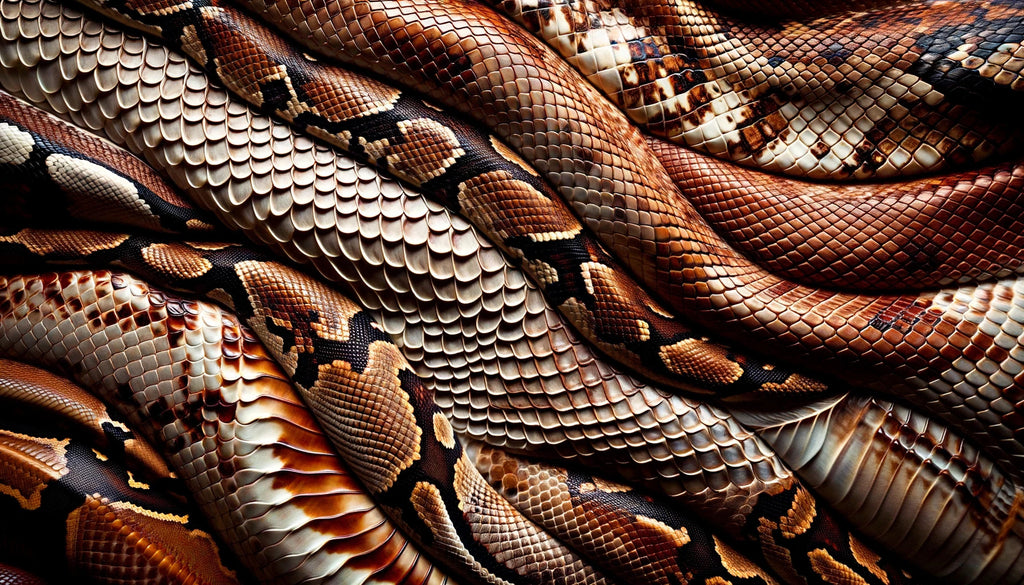
4. Lizard and Iguana Leather
Lizard and iguana leathers, with their intricate patterns and fine grains, are a testament to nature's artistry. Often used in high-end accessories, these leathers strike a balance between elegance and exotic charm. Dive with me into the world of lizard and iguana leathers, understanding their essence, advantages, uses, and care tips.
Definition
Lizard and iguana leathers are characterized by their fine, consistent grain patterns. These skins, often sourced from species like the monitor lizard or the iguana, have smaller scales compared to their reptilian counterparts like crocodiles or snakes. The finesse of these fine grains gives lizard and iguana leathers a smooth texture and a subtle sheen, making them a sophisticated choice for luxury items.
Pros & Cons
Pros:
- Elegance: The fine grain and smooth texture of lizard leather give it a refined appearance.
- Versatility: Suitable for smaller items like wallets, belts, and watch straps due to its flexibility.
- Durability: Resistant to wear and tear, ensuring longevity.
Cons:
- Sourcing Considerations: Some lizard species are endangered, making it essential to ensure ethical sourcing.
- Maintenance: Requires regular conditioning to prevent drying and cracking.
- Price: The meticulous processing and rarity can result in higher costs.
Applications
When we think of where lizard and iguana leather shines the most, a few applications immediately come to mind:
- Watch Straps: The leather's smooth texture and durability make it a favorite for luxury watch brands.
- Wallets: Compact yet sturdy, lizard and iguana leather wallets are a blend of style and function.
- Footwear: From formal shoes to chic sandals, this leather adds a touch of elegance to any footwear.
Expert Tips
Having been in the leather industry for a while, I've picked up a few tips and tricks along the way. Here are some recommendations for anyone considering lizard or iguana leather products:
- Preservation: Regularly clean and condition the leather to maintain its luster.
- Ethical Purchasing: Always verify the source of the leather. Opt for brands that prioritize sustainable and ethical sourcing.
- Storage: Store in a cool, dry place away from direct sunlight to prevent fading.
As they say, "Lizard and iguana leather might not make you a reptile expert, but it sure will make you a style connoisseur!" Remember, while the allure of exotic leather is undeniable, it's always essential to make informed and ethical choices. After all, luxury is best enjoyed when it's guilt-free.
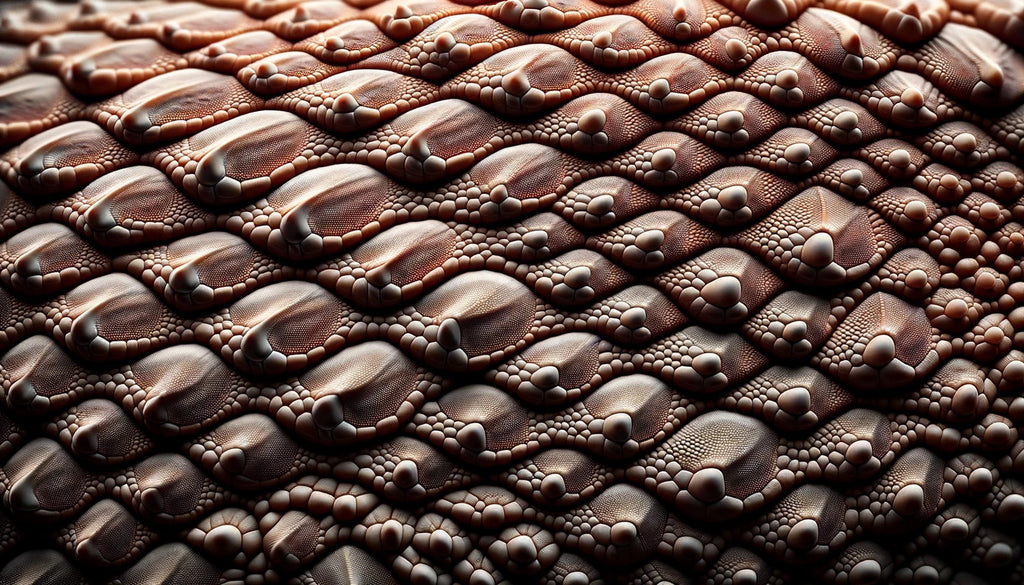
5. Stingray (Shagreen) Leather
Stingray leather, also known as shagreen, is a testament to luxury that's both ancient and modern. With a beaded texture reminiscent of pearls, this leather has historical significance and contemporary appeal. Let's embark on a journey to explore the allure of stingray leather, its strengths, unique applications, and expert care insights.
Definition
Stingray leather, often referred to as shagreen, is truly one-of-a-kind. It's known for its beaded texture, resulting from the calcified papillae on the skin's surface. Historically, shagreen was used in art deco furnishings and even as a grip on Japanese swords. Its beaded allure and durability make stingray leather a unique and luxurious choice.
Pros and Cons
Pros:
- Durability: Stingray leather is incredibly tough, resistant to water, and almost immune to scratches.
- Unique Texture: The beaded texture of stingray leather is unlike any other, making it stand out.
- Historical Significance: Historically used in various cultures for armor and decorative purposes.
Cons:
- Limited Versatility: The distinct texture might not be everyone's preference and may not suit all applications.
- Stiffness: Can be stiffer compared to other leathers, which might limit its use in certain products.
- Price: The intricate processing involved can make it more expensive.
Applications
Over the years, we've seen stingray leather grace various products. Its unique texture makes it a favorite for decor items, adding a touch of luxury to any space. In the realm of personal accessories, shagreen is often used for jewelry boxes, watch straps, and even some high-end handbags. Its resilience and distinct appearance also make it a popular choice for crafting statement jewelry pieces.
Expert Tips
If you're considering investing in a stingray leather product, here are some pointers I'd like to share:
- Purchase from Reputed Sellers: Always ensure you're buying genuine stingray leather. Look for certifications or buy from well-known brands.
- Care and Maintenance: While stingray leather is durable, it still requires care. Use a damp cloth for cleaning and avoid abrasive materials that might damage the beads.
- Appreciate its Uniqueness: Each piece of stingray leather is unique, with variations in bead size and pattern. Embrace these natural variations as a testament to its authenticity.
- Consider its Texture: If you're looking for a smooth finish, stingray might not be the best choice. However, for those who appreciate its unique texture, it's unparalleled.
Stingray leather, with its rich history and distinctive appearance, offers a blend of durability and luxury. While it might not be everyone's cup of tea, for those who resonate with its charm, it's a treasure worth having. And remember, whether you're a seasoned collector or a curious newbie, always approach your purchases with knowledge and discernment.
![]()
6. Kangaroo Leather
Bounding into the spotlight for its lightweight strength is kangaroo leather. Native to the vast landscapes of Australia, kangaroo leather offers a unique combination of durability and flexibility. Let's hop into the world of kangaroo leather, understanding its characteristics, benefits, dominant applications, and expert guidance.
Definition
Kangaroo leather, often referred to as "k-leather" in the industry, is sourced from the kangaroo, a marsupial native to Australia. What's fascinating about this leather is its unique combination of being incredibly lightweight yet exceptionally strong. It's almost like nature's paradox – how can something so light be so durable? But that's the magic of kangaroo leather.
Pros and Cons
Every material has its strengths and weaknesses, and kangaroo leather is no exception.
Pros:
- Performance: One of the primary reasons many prefer kangaroo leather, especially in the sports industry, is its performance. Its natural elasticity ensures a snug fit, making it ideal for athletic gear.
- Durability: Despite its lightweight nature, it offers impressive abrasion resistance.
Cons:
- Ethical Concerns: The sourcing of kangaroo leather has been a topic of debate. While some argue that kangaroo culling is essential for population control, others believe it's inhumane.
- Legal Restrictions: Due to these ethical concerns, some countries have imposed restrictions on the import and sale of kangaroo leather products.
Applications
When we talk about kangaroo leather applications, athletic footwear undoubtedly takes center stage. If you've ever worn a pair of soccer cleats or rugby boots made from kangaroo leather, you'll know the difference. The snug fit, the feel of the ball, the comfort – it's unparalleled. But it's not just limited to footwear. We also see kangaroo leather making its mark in gloves, offering wearers a tactile advantage.
Expert Tips
Navigating the world of exotic leathers can be daunting, but I'm here to help. Here are some nuggets of wisdom I've gathered over the years:
- Sourcing: Always ensure that the kangaroo leather you're purchasing is ethically sourced. Look for certifications or buy from reputed brands.
- Maintenance: Kangaroo leather, like other exotic leathers, requires care. Use a good quality leather conditioner to keep it supple.
- Storage: Store in a cool, dry place. Avoid direct sunlight, which can cause the leather to fade or become brittle.
Kangaroo leather is truly one of nature's marvels. It's a testament to how something so delicate can be so resilient. Whether you're considering it for its performance, aesthetics, or sheer curiosity, always make an informed choice. And remember, a little humor never hurt anyone – just like kangaroos, sometimes you've got to take a leap of faith.
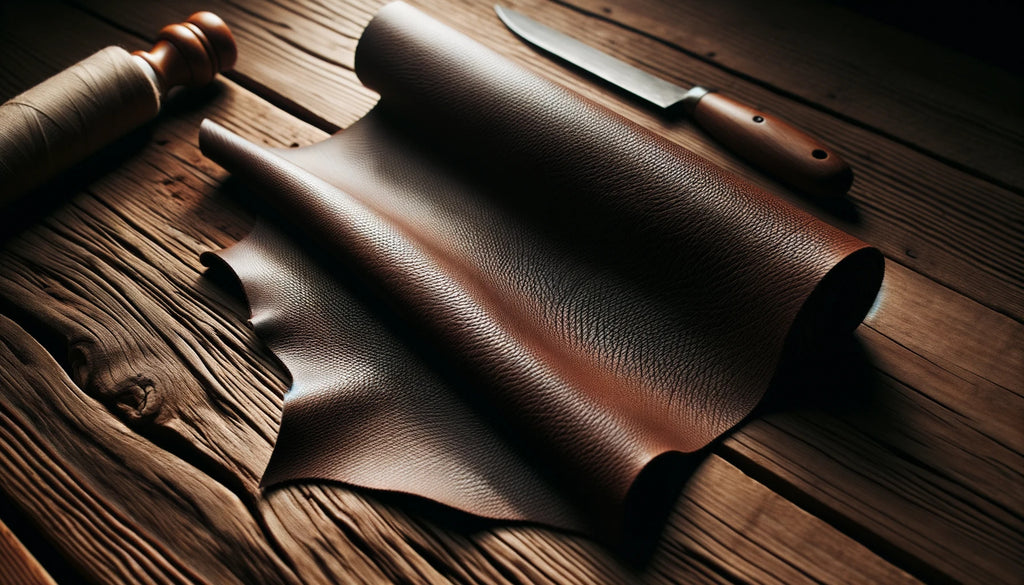
III. Navigating the Ethical and Legal Terrain of Exotic Leather
1. CITES and Responsible Sourcing
In my journey through the world of exotic leathers, I've come to realize the importance of sustainable trade. Enter CITES - the Convention on International Trade in Endangered Species of Wild Fauna and Flora. This international agreement plays a pivotal role in ensuring that the trade of wild animal and plant species does not threaten their survival.
When it comes to exotic leather, CITES regulations are paramount. They ensure that the skins we so cherish come from sources that prioritize conservation and sustainability. For instance, the trade of certain crocodile species is closely monitored, with permits ensuring that the leather is sourced responsibly. It's a testament to the global commitment to balance luxury with conservation.
2. Ethical Considerations in Exotic Leather Trade
As we indulge in the luxury of exotic leathers, it's essential to ponder the ethical implications. The balance between luxury and conservation is delicate. On one hand, we have the undeniable allure of these skins; on the other, the pressing need for conservation.
Many brands today are leading the way in ethical sourcing and production. They collaborate with local communities, ensuring not only the conservation of species but also the well-being of those involved in the sourcing process. By supporting these brands, we're not just acquiring a piece of luxury; we're also contributing to a larger, noble cause.
3. Legal Implications and Restrictions
Diving deeper into the realm of exotic leather, one cannot overlook the legal landscape. Different countries have varied regulations concerning the trade, possession, and sale of exotic skins. Understanding these is crucial, both for businesses and consumers.
For instance, while alligator leather might be legal in one country, its trade might be restricted in another. Ignorance of these laws can lead to severe consequences, including hefty fines or even imprisonment. It's not just about owning a piece of luxury; it's about owning it responsibly.
4. Consumer Responsibility
Lastly, I'd like to touch upon our role as consumers. We're not just passive buyers; we're active participants in the trade of exotic leather. Our choices can shape the industry, promoting ethical and sustainable practices.
Before making a purchase, it's imperative to verify the authenticity and ethical sourcing of the product. Ask questions, seek certifications, and be an informed consumer. Remember, every purchase is a statement, a reflection of our values. Let's ensure that our love for luxury doesn't overshadow our commitment to ethics and sustainability.
In this intricate dance of luxury, ethics, and legality, knowledge is power. As we navigate the world of exotic leathers, let's do so with awareness, responsibility, and a deep appreciation for the beauty and rarity of these skins.
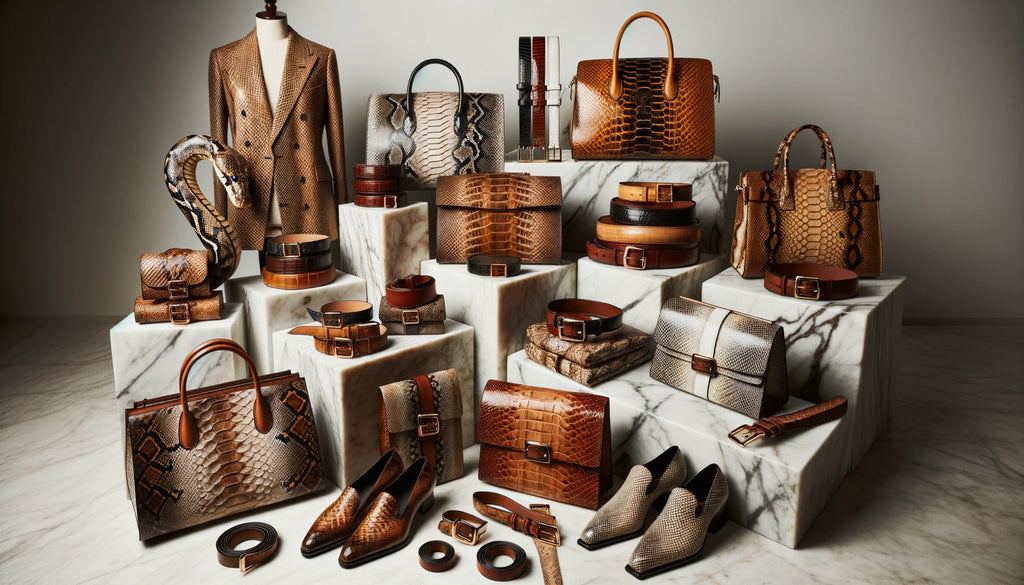
IV. How to Care for Exotic Leather?
1. Understanding the Unique Needs of Exotic Skins
Every time I hold a piece of exotic leather, I'm reminded of its uniqueness. Each type, be it crocodile, ostrich, or python, has its distinct care requirements. It's not just about preserving its beauty; it's about understanding its essence.
The environment plays a crucial role in the care of exotic leathers. For instance, while some skins might thrive in a slightly humid environment, others might need a drier setting. Similarly, how we use our exotic leather items, whether it's an occasional luxury handbag or a frequently worn pair of shoes, will determine its maintenance needs. It's a dance between nature, luxury, and care.
2. Cleaning and Conditioning
Cleaning and conditioning exotic leather isn't just a routine; it's an art. Each leather type has its tailored care techniques, resonating with its unique texture and structure.
For instance, while a gentle brush might work wonders on ostrich leather, it might not be suitable for the delicate scales of snake leather. Similarly, the conditioner that adds a lustrous sheen to alligator skin might not suit the porous texture of kangaroo leather. It's all about finding products and methods that resonate with the essence of each leather type.
3. Storage and Preservation
Imagine crafting a sanctuary for your exotic treasures. A place where they're not just stored but celebrated. Proper storage is crucial to prevent damage, wear, and tear.
For those exquisite handbags, consider using padded inserts to retain their shape. Shoes? Cedar shoe trees can be your best friend. And always, always keep them away from direct sunlight, which can fade their rich colors. Remember, it's not just about preserving their beauty; it's about honoring their rarity.
4. Repair and Restoration
Even with the best care, there might come a time when your exotic leather item needs a touch-up or repair. While professional help is recommended for significant issues, there are DIY methods for minor repairs.
Got a small scratch on your python leather wallet? A gentle rub with a conditioning cream might just do the trick. Noticed some scales lifting on your lizard leather handbag? A soft brush can help lay them flat. But always remember, when in doubt, seek professional help. It's about restoring not just the leather but its soul.
5. Longevity and Protection
The allure of exotic leather lies in its timeless beauty. And with proper care, this beauty can last for generations. Protective measures, like using rain protectants for unexpected showers or dust bags for storage, can go a long way.
Consider the environment, the potential hazards, and craft a care routine that ensures the beauty of your exotic leather lasts. After all, it's not just a piece of luxury; it's a legacy.
Caring for exotic leather is a journey, one that requires knowledge, patience, and a deep appreciation for its beauty and rarity. As we navigate this journey, let's do so with love, care, and the reverence that these exquisite skins deserve.
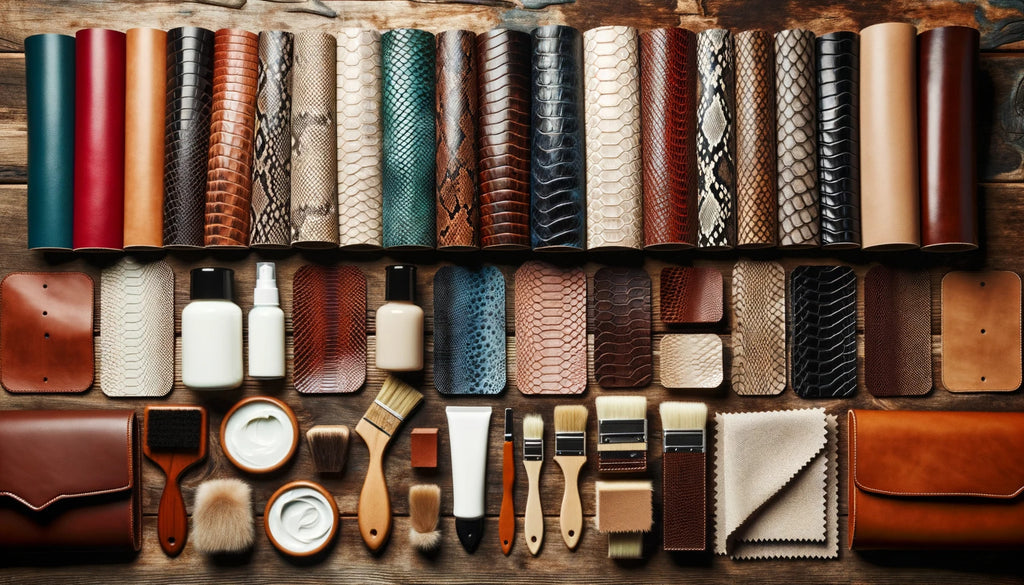
Conclusion
The journey through the world of exotic leathers is undoubtedly a luxurious one. From the rich textures to the intricate patterns, each type of leather tells a unique story. However, as consumers, it's essential to approach this luxury with a sense of responsibility.
Embracing the beauty of exotic leathers means not only appreciating their aesthetic appeal but also understanding the ethical, legal, and environmental implications of their production and purchase.
FAQs
How do I authenticate exotic leather products?
Authenticating exotic leather products usually involves checking for certification, trademarks, or holograms from recognized organizations. Additionally, familiarizing oneself with the texture, smell, and appearance of genuine leathers can be helpful. When in doubt, seeking expert opinion or buying from reputable brands can ensure authenticity.
What are the considerations in ethically sourcing exotic leather?
Ethical sourcing involves ensuring that the leather is obtained without causing harm to endangered species, and that the animals are treated humanely. It's crucial to verify that the leather is sourced from farms or facilities that adhere to ethical and sustainable practices.
How do I ensure the longevity of my exotic leather items?
Proper care and maintenance are vital. Avoiding direct sunlight, keeping the items away from moisture, using specialized cleaning products, and storing in a cool, dry place can help maintain their appearance and prolong their life.
What are the legal aspects of buying and owning exotic leather products?
Different countries have regulations regarding the import, export, and sale of exotic leathers, especially if they are derived from endangered species. It's essential to be aware of the CITES (Convention on International Trade in Endangered Species) regulations and any other local laws.
Which exotic leather is considered the most luxurious?
While luxury is subjective, crocodile and alligator leathers are often considered among the most luxurious due to their rarity, texture, and the intricate processes involved in their production.
How do brands ensure the sustainability of exotic leather products?
Many brands now prioritize sustainability by sourcing leather from farms that use sustainable breeding practices, reducing waste in production, and supporting conservation efforts.
What are the key considerations in storing exotic leather items?
Store them away from direct sunlight and moisture. Use padded hangers for leather garments and stuff bags and shoes to maintain their shape. Additionally, regular conditioning can prevent the leather from drying out.
How does the exotic leather industry contribute to conservation efforts?
Some farms and brands contribute a portion of their profits to conservation efforts. Additionally, sustainable farming of certain animals can help in increasing their population and preventing their extinction.
What are the emerging trends in the exotic leather market?
With increasing awareness about sustainability, there's a trend towards more responsible sourcing and production. Vegan and lab-grown leathers are also gaining popularity as alternatives.
How do I make an informed purchase of an exotic leather product?
Research the brand and its sourcing practices, understand the legal implications, and educate yourself on the characteristics of genuine exotic leather. Reading reviews and seeking expert opinions can also guide you in making an informed decision.
📫 Related Blog Posts:
📌 How to Rehydrate Leather? Leather Rehydration Made Easy
📌 How to Get Water Stains Out of Leather? Erase Water Marks Effortlessly
📌 Leather Care Essentials: Best Oils and Maintenance Practices
📌 How to Get Smell Out of Leather? Say Goodbye to Leather Odors
📌 How to Restore Leather? A Complete Guide to Revive Your Leather
📌 Best Leather Anniversary Gifts: Celebrate Love with Timeless Elegance
📌 How to Stiffen Leather Like a Pro? From Supple to Sturdy
📌 DIY Leather Conditioners: Nature's Touch for Timeless Elegance
📌 Embossed vs. Engraved Leather: The Artistic Duel Unveiled
📌 Mastering the Art of Leather Lacing: A Comprehensive Guide
1 comment





Great article! The detailed insights on exotic leather are both informative and fascinating. Appreciate the effort in breaking down the different types and their unique qualities!
Leave a comment